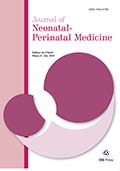Authors: Calkins, K. | Roy, D. | Molchan, L. | Bradley, L. | Grogan, T. | Elashoff, D. | Walker, V.
Article Type:
Research Article
Abstract:
OBJECTIVE: To determine the predictive ability of cord blood bilirubin (CBB) for hyperbilirubinemia in a population at risk for maternal-fetal blood group incompatibility and hemolytic disease of the newborn. STUDY DESIGN: This is a single center retrospective case-control study. Cases received phototherapy; controls did not. Cases were matched 1:3 to controls by gender and treating physician. Inclusion criteria included: ≥35 weeks gestation, CBB, and one or more total serum bilirubin (TSB) concentrations. The primary outcome was CBB. Secondary outcomes were a TSB >75th percentile, length of stay, and neonatal intensive care unit admission. The prognostic
…ability of CBB for phototherapy and TSB >75th percentile was assessed using area under the receiver operating characteristic (ROC) curve. Logistic regression analyses were performed to determine predictors for phototherapy and TSB >75th percentile. RESULT: When compared to controls (n = 142), cases (n = 54) were more likely to have a positive Coombs’ test (82% vs. 41% , p < 0.001) and TSB >75th percentile (85% vs. 21% , p < 0.001). When compared to controls, cases had a higher mean (±SD) CBB (2.5 ± 0.5 vs. 1.8 ± 0.4 mg/dL, p < 0.001). The area under the ROC curve (±SEM) for CBB for phototherapy and TSB >75th percentile was 0.87 ± 0.03 (p < 0.001, 95% CI 0.82, 0.93) and 0.87 ± 0.03 (p < 0.001, 95% CI 0.82, 0.92), respectively. CONCLUSION: In this study, the mean CBB concentration was higher in neonates who received phototherapy compared to those who did not. CBB concentrations may help predict severe hyperbilirubinemia and phototherapy in a population at risk for hemolytic disease of the newborn.
Show more
Keywords: Bilirubin, neonates, phototherapy, hemolytic disease
DOI: 10.3233/NPM-15814111
Citation: Journal of Neonatal-Perinatal Medicine,
vol. 8, no. 3, pp. 243-250, 2015
Price: EUR 27.50





